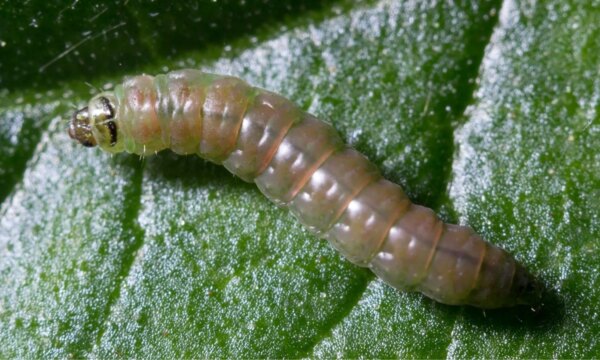
Tuta absoluta © Marja van der Straten
Tuta absoluta is a major invasive pest that causes devastating crop damage worldwide. Insecticides are heavily relied upon to help curb their numbers, but because of problems with increased insecticide resistance and the environmental impacts of insecticides, scientists are trying to find new ways of fighting this pest.
To try to find new ways of controlling T. absoluta, researchers looked at the effects of a novel biopesticide (Prev-Am®), a synthetic insecticide (Lambda-cyhalothrin) and a natural predator (Nesidiocoris tenuis) on T. absoluta populations. When the biopesticide and synthetic insecticide were tested individually, the biopesticide (at a 50% concentration) was either just as good as, or better than the synthetic pesticide at reducing the numbers of T. absoluta. When the biopesticide (at a 50% concentration) was used with N. tenuis, there was a greater reduction in the number of T. absoluta individuals compared with when the synthetic pesticide was used with N. tenuis.
Researchers also tested the effect of the biopesticide and the synthetic pesticide on N. tenuis to see if the species’ behaviour or life expectancy were affected. Their conclusion showed that whereas there were some behavioural changes in N. tenuis when treated with the biopesticide, survival rate was not affected. Further, whilst the biopesticide appeared to slightly reduce the rate at which N. tenuis predated on T. absoluta, this was much less than the reduction in preying behaviour seen when a synthetic insecticide was used. Further, when treated with the biopesticide, the rate at which N. tenuis fed on the plants was reduced – this is important as occasionally this species becoming a pest itself by feeding on the plants when its prey are scarce.
These findings highlight an alternative approach to curbing pervasive invasive pests such as T. absoluta. By combining biopesticides with natural predators, the potential negative impacts of pest control on the environment could be greatly reduced. Indeed, making use of a combination approach prevents one single strong selection pressure being applied to the pest, and could therefore actually reduce the rate at which pests develop resistance. Such approaches will become more and more appealing as the rates of insecticide resistance continue to rise.
For more information on this study, read the article in full: Botanical insecticide and natural enemies: a potential combination for pest management against Tuta absoluta
3 Comments
Leave a Reply
Related News & Blogs
CABI highlights benefits of Pest Risk Analysis (PRA) support tools to fight invasive species in Caribbean
Larval damage CABI’s experts in the field of invasive species management have highlighted the benefits of the CABI Horizon Scanning (HS) Tool and CABI Pest Risk Analysis (PRA) Tool to help fight a range of invasive species in the Caribbean. Naitram Ram…
26 July 2022





[…] Two heads may be better than one: using multiple methods in the fight against Tuta absoluta […]
[…] Two heads may be better than one: using multiple methods in the fight against Tuta absoluta […]
[…] Two heads may be better than one: using multiple methods in the fight against Tuta absoluta […]